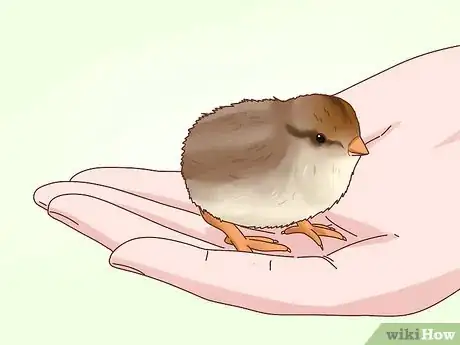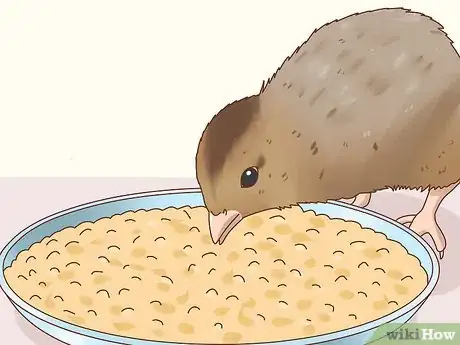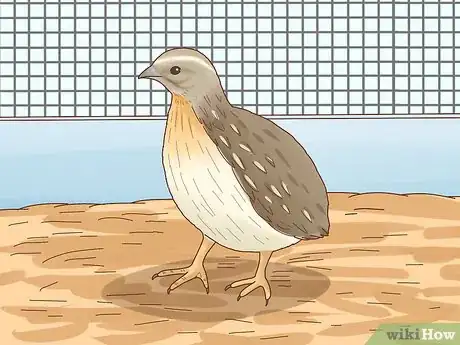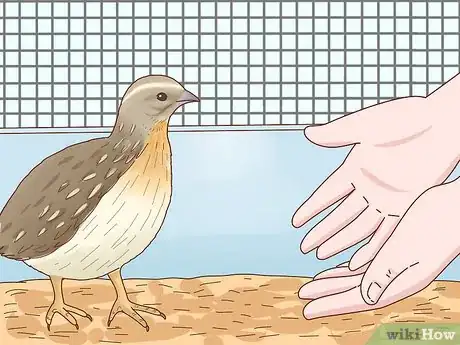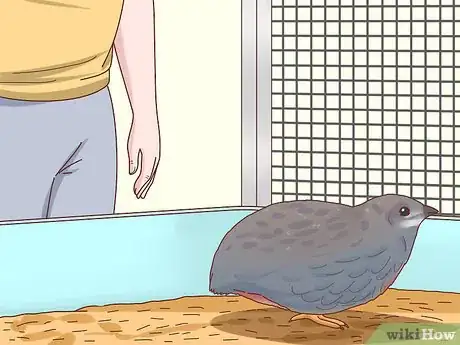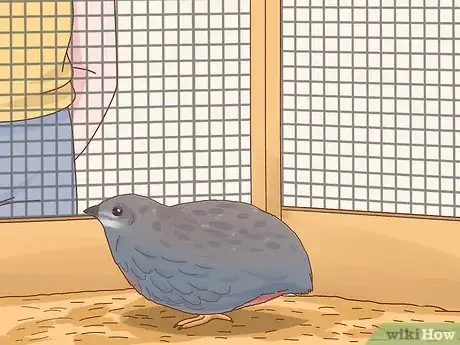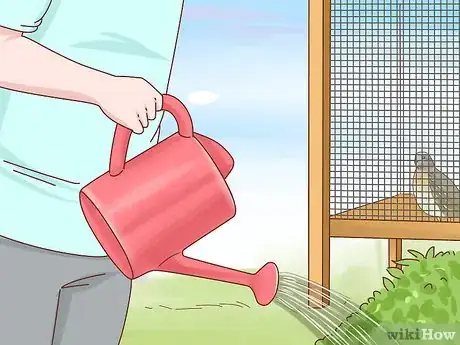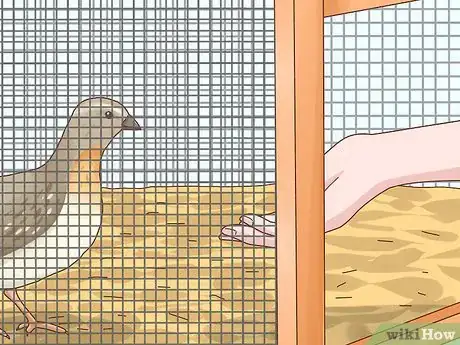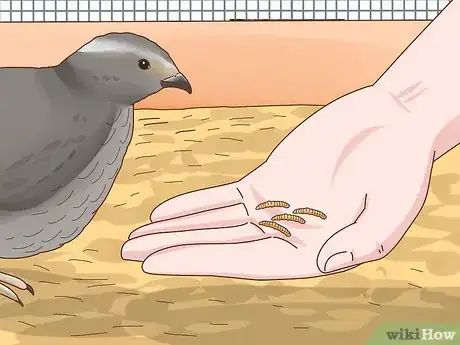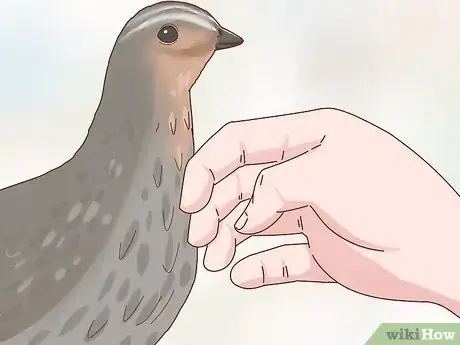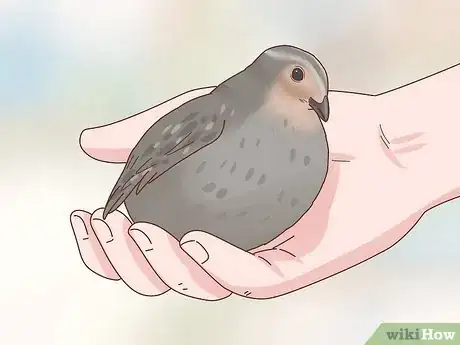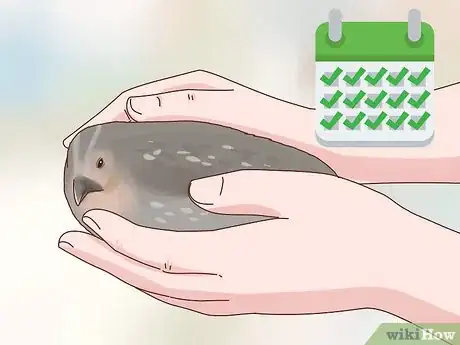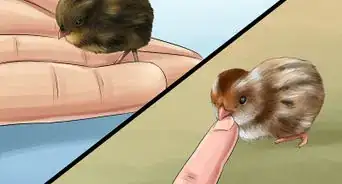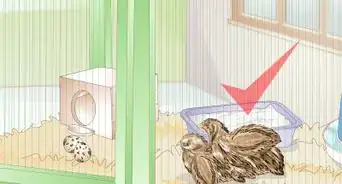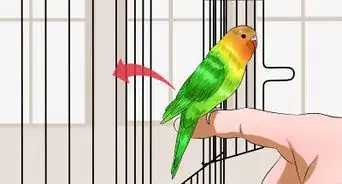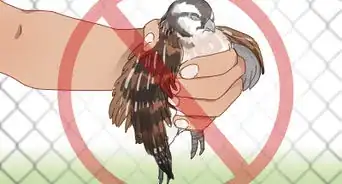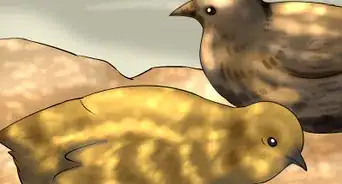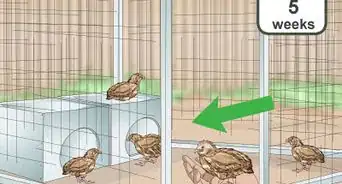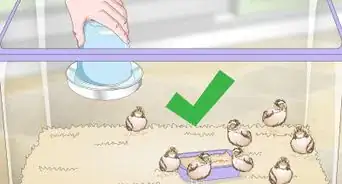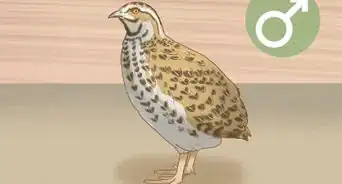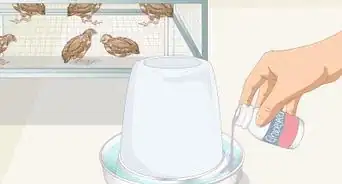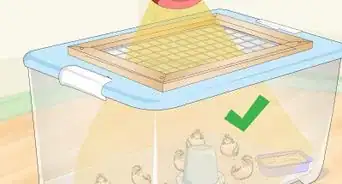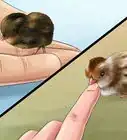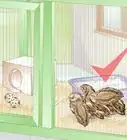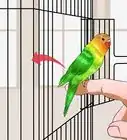This article was co-authored by wikiHow staff writer, Christopher M. Osborne, PhD, and Amy Harrison, a trusted member of wikiHow's volunteer community. Amy Harrison has over five years of experience working directly with poultry. She has worked on a rural chicken farm built around marketing free-range eggs, where she managed the care for the poultry year-round. She has experience breeding chickens and quail, caring for newborn poultry, handling their health issues, and managing their dietary needs.
wikiHow marks an article as reader-approved once it receives enough positive feedback. In this case, 90% of readers who voted found the article helpful, earning it our reader-approved status.
This article has been viewed 50,179 times.
Learn more...
Quail are small birds that can be kept as pets, and in some cases can become tamed pets. However, taming quail—and especially adult quail—is not easy and takes a lot of patience due to their skittish nature. Your best bet is to provide proper care, slowly get the quail used to your presence, and then try to get the bird more comfortable interacting with you.
Steps
Starting the Process Patiently and Realistically
-
1Tame hatchlings instead of adults if possible. Quail are skittish by nature and are not easy animals to tame. This is especially true for fully-grown quail. So, if you already have untamed adult quail, consider whether you actually want or need to tame them.[1]
- As an alternative, consider purchasing fertile quail eggs and incubating them. It’s far easier to tame baby quail than adults—primarily you just need to interact with them calmly and care for them properly.
-
2Care for your quail properly. The happier your quail, the better your chances of taming them. Give them a high-quality feed and fresh water, eliminate disturbances, house them in a spacious and clean enclosure, and keep an eye out for potential illnesses.[2]
- Caring for them daily also means that you’ll interact with them daily. This helps them get used to your presence, which is essential for taming them.
Advertisement -
3Give a new adult quail time to adjust before introducing taming. Allow the new quail time to settle in. Interacting more than necessary straight away can cause excessive stress, so give them at least a week to adjust to you and their new surroundings.[3]
- For the first week or so, interact only as much as is required to provide proper care.
-
4Maintain your temper and your patience if you want to succeed. You cannot tame quail, and especially adult quail, through fear or force—they’ll simply become terrified of you. Never grab them forcefully, shout at them, chase after them (unless they get away!), or approach them from behind or above.[4]
- Don’t try to set a deadline for taming your adult quail. The process has to occur on their time, if at all.
-
5Don’t force taming on a quail that rejects it. It’s essential that you accept the fact that not every adult quail can be tamed. They are inherently skittish and fearful creatures, and some of them can’t be trained to overcome this nature.[5]
- Some quail-lovers say that button quail are extremely hard to tame, while coturnix and bobwhite are a little easier to tame. That said, the temperament of the individual bird is at least as important as its breed.
Building Familiarity with Your Presence
-
1Approach the quail as closely as they’ll allow each day. At a time other than a feeding or other care routine each day, walk slowly and calmly toward the quail enclosure. Get as close as you can without the quail reacting fearfully—running along the sides of the enclosure is the most obvious sign. Ideally, you’ll be able to move this “safe spot” a bit closer each day without causing distress.[6]
- If they react fearfully as soon as you’re in sight, remain as far away as you can while still being in view. Hopefully, over time, they’ll settle down. If not, the quail may not be tameable.
- Each day, try moving the “safe spot” a bit closer, until the quail respond negatively. Then, back up until they calm down. After a few weeks, your “safe spot” will ideally be right next to the enclosure.
-
2Sit quietly by the quail in your “safe spot” for 20 minutes per day. Taming a quail starts with getting them used to your presence so they recognize you’re not a threat. Sit as close as the quail will allow every day and make sure the quail can see you.[7]
- Sit there for at least 20 minutes each day. This doesn’t mean that you have to do nothing during the time—you can read a book if you like. Just make sure you’re not moving about or talking loudly, or you’ll just frighten the quail.
-
3Talk to the quail once you can sit quietly next to them. After you’re able to establish your “safe spot” right next to the enclosure, try vocalizing to the quail calmly and reassuringly. Talk in to the quail in a gentle voice, like you would with a sick friend, or try whistling or singing quietly.[8]
- Don’t talk or sing loudly, and definitely don’t shout. Focus on being calming and comforting. Look toward the quail as you vocalize.
- Try something like: “Hello, Quincy, don’t you look happy today? I see you’ve been eating your food…”
-
4Perform routine tasks within view of the quail. After vocalizing in the “safe spot” for a week, try doing common tasks just outside the enclosure while continuing to talk to the quail. If you’re outdoors, try raking leaves, tending the garden, or something similar. If you’re indoors, try an activity like sweeping the floor or watering the houseplants.[9]
- Avoid noisy tasks such as vacuuming, mowing the lawn, or dancing to loud music.
- If they respond negatively when you start the task, return to sitting and try again the following day.
Feeding, Petting, and Holding by Hand
-
1Stick your hand in the quail enclosure for up to 10 minutes. Once the quail can remain calm with you just outside the enclosure, try reaching your hand carefully and slowly into the enclosure. Hold your palm open and keep your hand as still as possible.[10]
- If the quail reacts negatively, remove your hand and try again the next day.
- Keep extending the time you keep your hand in the enclosure until you can do so for 10 minutes without the quail responding negatively.
- Once you reach 10 minutes, or if the quail calmly approaches your hand regularly, you can move on in the training process.
-
2Offer the quail treats from your open hand. Repeat the normal hand-in-enclosure process, but place some quail feed or a treat they enjoy—mealworms, for instance—in your open palm. If they don’t come to feed from your hand within 10 minutes, try again the next day.[11]
- Don’t try to force your hand into their face to take the treat. Be patient, and let the quail choose to come and take the treat on their own terms. Eventually, they will likely overcome their innate fear and eat from your hand.
- Once they do eat from your hand, try talking to them in your soothing voice afterward. Then, the next day, try talking to them while they eat.
-
3Try petting the quail. Once the quail remains calm and in the area after eating from your hand, try slowly lifting your fingers to pet it just beneath its neck. If it reacts negatively, return your hand to the open position and leave it there calmly, then try again the next day.[12]
- Once the quail allows you to pet it under its neck, try petting it very gently on the back of its head. Bring your hand up over its head slowly so you don’t surprise it.
- Some quail will never permit being petted from above. In the wild, they are attacked from above by predators (usually larger birds), so they are naturally skittish about this.
-
4Attempt to pick up the quail calmly. Once the quail is completely comfortable around your hand, see if you can get it to hop up onto your hand in order to reach a treat. Once it does, try very slowly lifting it. If it starts to panic, lower your hand and try again the next day.[13]
- If the quail allows you to lift it, bring up your other hand and cup them very gently around the sides of the quail. Don’t squeeze it or envelop it in your hands—just have your hands ready to prevent a potential fall or escape attempt.
-
5Keep up with your daily routine. Spend a dedicated amount of time every day working with your quail. In some cases, quail can become comfortable enough to remain calm in your hands for long stretches.[14]
- Don’t try to teach the quail to perch on your shoulder. Even a tame quail can get spooked easily and risk injury through a fall or escape attempt.
Community Q&A
-
QuestionWhat does it mean when my quail runs side-to-side, along the cage?
 Community AnswerThis is a sign that your quail is stressed or scared. Even if the quail walks on/over your hands, it is frightened of you or any animals nearby. Try backing away or sitting down to the birds eye level. Slowly approach it using your hand and try to feed it some food.
Community AnswerThis is a sign that your quail is stressed or scared. Even if the quail walks on/over your hands, it is frightened of you or any animals nearby. Try backing away or sitting down to the birds eye level. Slowly approach it using your hand and try to feed it some food. -
QuestionWhy does my quail become so wild outside of the cage?
 Community AnswerIt could be a number of reasons - maybe your bird is just excited to have some freedom. Work on using treats as a motivator for good behavior when your bird is out of the cage so they'll become less wild over time.
Community AnswerIt could be a number of reasons - maybe your bird is just excited to have some freedom. Work on using treats as a motivator for good behavior when your bird is out of the cage so they'll become less wild over time. -
QuestionWhy are my quails so calm when outside their cage but crazy when inside it?
 Community AnswerAll animals hate being in cages. Is your cage perhaps too small?
Community AnswerAll animals hate being in cages. Is your cage perhaps too small?
Things You’ll Need
- High-quality quail feed
- Spacious cage
- Fresh water
- Treats
- Lots of patience!
Warnings
- Don’t hurt your quail just because it isn’t interacting with you or runs away from you. This is just the quail's instinct to keep it out of danger.⧼thumbs_response⧽
- No matter how tame your quail is, never let them out of either a secure enclosure or your direct view. Predators, including cats, dogs, and birds, can attack quickly.⧼thumbs_response⧽
- Quail are not the type of birds you train to do tricks or to talk. If you are taming your quail so you can get them to perform tricks, you’re wasting your time.⧼thumbs_response⧽
References
- ↑ https://www.roysfarm.com/how-to-tame-quail/
- ↑ https://www.youtube.com/watch?v=y5pninvmy0E
- ↑ https://www.roysfarm.com/how-to-tame-quail/
- ↑ https://www.roysfarm.com/how-to-tame-quail/
- ↑ https://www.backyardchickens.com/threads/how-can-i-tame-my-quail.414862/
- ↑ https://www.backyardchickens.com/threads/how-can-i-tame-my-quail.414862/
- ↑ https://www.backyardchickens.com/threads/how-can-i-tame-my-quail.414862/
- ↑ https://www.roysfarm.com/how-to-tame-quail/
- ↑ https://www.roysfarm.com/how-to-tame-quail/
About This Article
To tame a fully grown quail, slowly approach the quail and get as close as you can without it reacting fearfully to establish a "safe spot." Next, sit quietly in this spot and speak soothingly to the quail for 20 minutes per day. Try to get a little closer to the quail each day until you're right next to the cage, then stick your hand into the cage so the quail can adjust to your presence. Finally, start offering the quail treats and try petting it gently. For tips on picking up the quail, read on!
